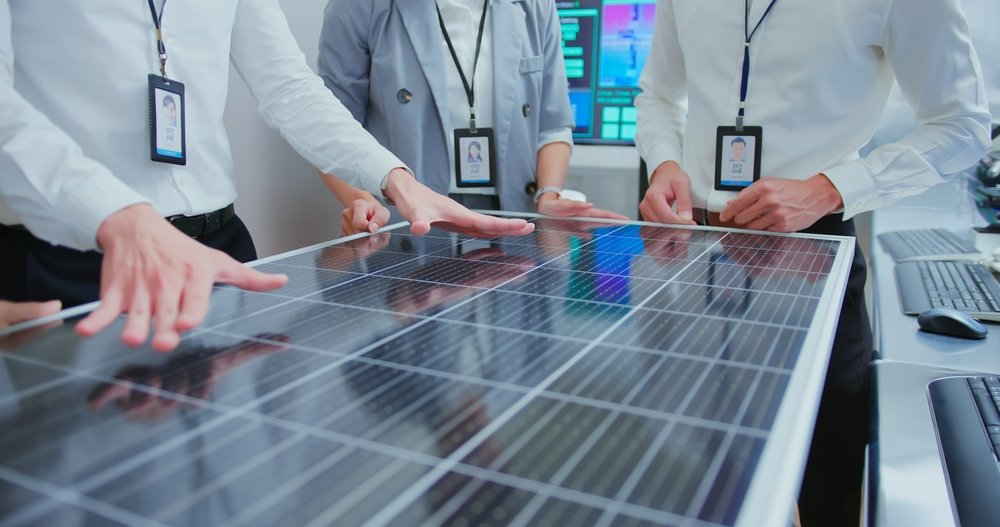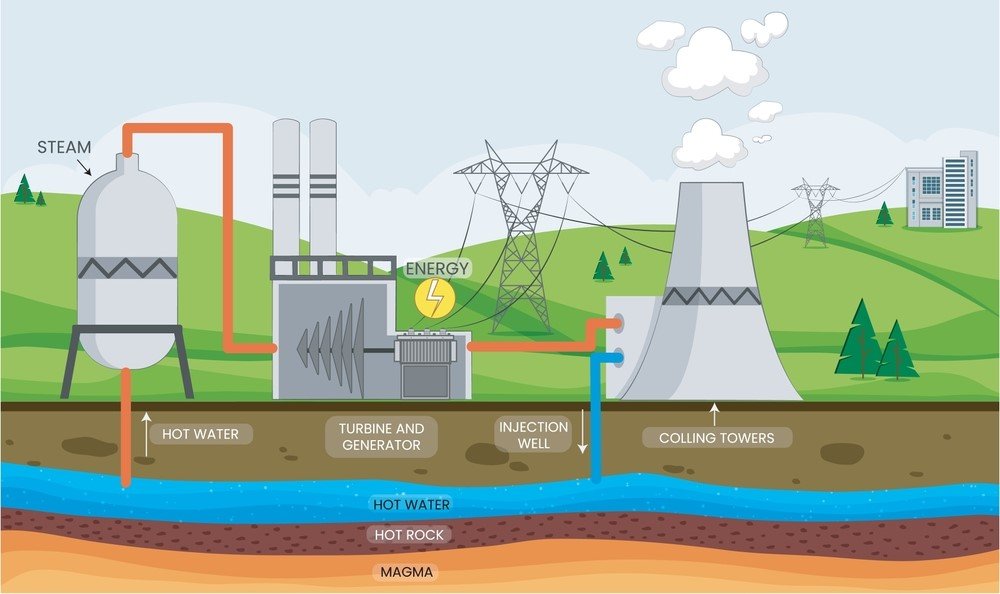Solar energy is a clean, renewable source obtained from sunlight radiation (abundantly available) and is further converted into electricity using solar panels. It is abundantly available. Whereas, Geothermal energy is heat obtained from the Earth’s interior, mostly from volcanic activity and radioactive decay.
Both Solar and Geothermal energy are renewable champions, but each of them shines in different ways of application.
- Solar energy is mostly used for residential, commercial, and industrial purposes.
- Geothermal energy is used for generating electricity, heat, or coolness using power plants or heat pumps.
Solar energy is always accessible as it requires only sunlight, in urban and rural areas. Geothermal energy is more location-specific, as it requires access to geothermal reservoirs, which are typically found near tectonic plate boundaries or volcanic regions.
Commonly worldwide, Solar energy is used more compared to geothermal energy, due to its versatility and accessibility. However, geothermal methodologies are gaining popularity in regions with abundant resources and as a long-lasting heating and cooling solution for buildings.
Most importantly, you must be aware of the Factors to compare solar energy vs geothermal energy including cost, location, efficiency, maintenance, environmental impact, and return on investment.
Let us further explore into similarities between solar and geothermal energy, including their renewable characteristics and potential as sustainable alternatives.
How does Solar Energy Work?

Solar energy is harnessed through the photovoltaic effect of the solar panels and works only when exposed to sunlight. Photons strike the solar panel made of semiconductor materials like silicon to create an electric field by knocking the loose electrons from the atoms within the material. The direct current (DC) is generated as electrons flow within the solar panels. Conversion of Direct Current (DC) into Alternating Current (AC) helps you to power homes, businesses, and other electrical devices through an inverter.
Solar energy can be used in two different ways, namely Photovoltaic (PV) and Solar Thermal Systems. The PV panels convert sunlight into electricity using semiconductor solar cells, whereas solar collectors absorb sunlight and circulate the heat, which can be used directly or stored for future use.
There are numerous benefits of solar energy, such as
- Abundant and renewable energy source.
- Lower operational costs.
- Reduced electricity bills for house owners and business individuals.
- Doesn’t emit any greenhouse gas emissions.
Simultaneously, certain drawbacks pose questions about its sustainability in the future, which include:
- Highly dependent on weather conditions.
- Requires significant land area leading to various issues like conflicts, exploitation, habitat destruction, and several others.
- Huge upfront costs.
- Storage challenges that require additional investment, like batteries.
- Harmful substances are released during the manufacturing process.
If you are planning to install a solar panel system, then you will need proper knowledge and understanding about what solar energy is, its pros and cons, and all other important facts.
How Does Geothermal Energy Work?

Different ways of extracting the heat:
Using the Steam Power, from the hot fluids that we can get underground while drilling deep wells. The steam generates electricity by spinning the turbines.
The Hot Water Systems are another option to heat homes, greenhouses, and even entire districts! Imagine pipes carrying hot water like underground heating systems. Instead of steam, hot water comes to the surface. It directly heats homes, greenhouses, and even swimming pools!
Geothermal Heat Pumps: These clever systems act like refrigerators in reverse, extracting heat from the shallower Earth (think a few hundred feet down) to heat buildings efficiently.
Applications of Geothermal:
Electricity generation: Clean, reliable power source for homes and businesses.
Heating: Cozy homes, greenhouses, and even entire districts!
Industrial uses: Drying food, pasteurizing milk, and even extracting minerals from rocks.
There are Benefits and Drawbacks of Geothermal Energy
Benefits:
- No harmful emissions, unlike fossil fuels.
- Works 24/7, unlike weather-dependent solar and wind.
- The heat source constantly replenishes itself.
Drawbacks:
- Not everywhere has accessible geothermal resources.
- Drilling and setting up power plants can be expensive.
- Emissions and water use depend on technology.
- Geothermal energy is a powerful, clean, and sustainable way to harness Earth’s internal heat for various uses.
{Video Credit- U.S. Department of Energy}
Solar Energy vs Geothermal Energy: Factors to Compare
Cost
The average cost of a solar system ranges from $14,000 to $24,000 for residential installations. Whereas, the average cost of Geothermal systems is more expensive as it ranges from $15,000 to $30,000.
Solar panel installation costs include equipment, labor, and permits, which can amount to $2,000 to $5,000. Geothermal installation costs are higher due to drilling and ground loop installation, ranging from $10,000 to $30,000.
Factors affecting solar costs include sunlight availability, system size, and equipment quality. Geothermal costs are influenced by the property’s geology, system size, and access to drilling equipment.
Solar energy tends to be more accessible and cost-effective for most residential owners due to lower upfront costs and simpler installation processes compared to geothermal systems.
Location
Solar energy is suitable for locations with ample sunlight, while geothermal systems are feasible in areas with accessible geothermal heat reservoirs.
Solar panel installation is generally easier as it involves mounting panels on rooftops or open land. Geothermal systems require drilling boreholes or trenches, making them more complex and labor-intensive.
Basically, Geothermal systems require less land area for installation compared to solar panels. Geothermal systems may need a few hundred square feet for drilling and ground loop installation, whereas solar panels require more space to generate equivalent energy.
Solar panels require sufficient unshaded space for optimal energy production, typically around 100 to 400 square feet (37.16 square meters) per kilowatt of installed capacity.
Efficiency
Solar panel efficiency ranges from 15% to 22% on average, depending on factors like sunlight intensity, panel orientation, and temperature.
Geothermal heat pump efficiency averages around 300% to 400%, meaning they can provide three to four units of heat for every unit of electricity consumed.
The efficiency of Solar panel efficiency can be affected by shading, dirt buildup, and temperature variations. Geothermal efficiency depends on soil or water temperature, system design, and maintenance.
Maintenance
Solar panels typically require maintenance once or twice a year, while geothermal systems may need maintenance every 1 to 3 years.
Remember always to remove dust and keep Solar panels clean to improve efficiency. However, frequent cleaning isn’t required for Geothermal systems but may need periodic checks for system performance.
Firstly, the Solar panel’s surfaces have to be clean for the best sunlight absorption. Whereas, Geothermal systems require regular checkups on pumps, filters, and ductwork.
Residential owners feel Solar panels are easier to maintain due to simple requirements and only few mechanical components compared to geothermal systems.
Environmental Impact
Solar energy has a positive environmental impact by reducing greenhouse gas emissions and reliance on fossil fuels. However, manufacturing solar panels involves some environmental footprint, including energy consumption and waste generation. There are also so many environmental impacts of solar energy you should know.
Geothermal energy has a minimal environmental impact compared to fossil fuels but may involve some land disturbance during installation and potential groundwater contamination risks if not properly managed.
Return on Investment
Homeowners can save an average of 50% to 75% on their energy bills by switching to solar or geothermal energy, depending on factors like system size, energy consumption, and local utility rates.
The payback period for solar systems typically ranges from 5 to 15 years, while geothermal systems may have longer payback periods of 10 to 20 years. However, both systems can offer substantial long-term savings on energy costs.
Conclusion: Which Is Better for you?
Is Solar Energy Cheaper Than Geothermal Energy?
Solar energy tends to have a lower average cost compared to geothermal energy systems. The initial investment for solar panels is generally lower than that of geothermal systems.
The installation costs of solar panels are almost always lower than geothermal systems, mainly due to simple installation processes and fewer equipment requirements.
Solar systems mostly have lower maintenance costs compared to geothermal systems, as they require less frequent and less intensive maintenance activities.
What Are the Similarities Between Solar and Geothermal Energy?
- Both solar and geothermal energies are renewable, meaning they are naturally replenished and will not run out.
- They contribute to reducing greenhouse gas emissions and helping combat climate change.
- Both can be utilized in heating and cooling applications for residential, commercial, and industrial purposes.
- They offer long-term cost-saving benefits by reducing reliance on conventional energy sources and lowering energy bills.
How Efficient is Geothermal Energy?
300% to 400% is the efficiency rating of Geothermal energy systems. It means that for every unit of electricity consumed, the system can produce 3 to 4 units of heat energy. This makes it a highly efficient heating and cooling solution.
Ray is an avid reader and writer with over 25 years of experience serving various domestic and multinational private and public energy companies in the USA.

